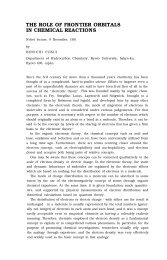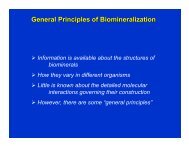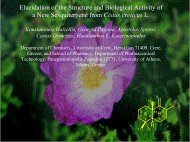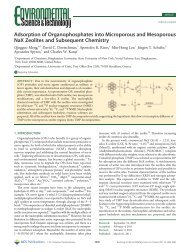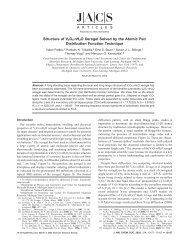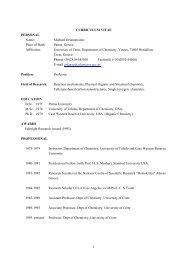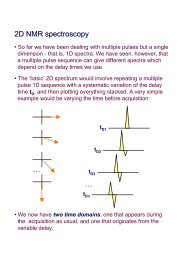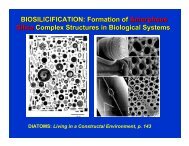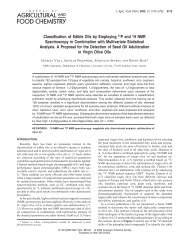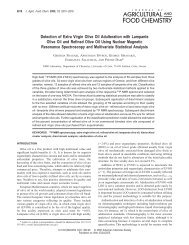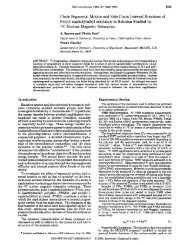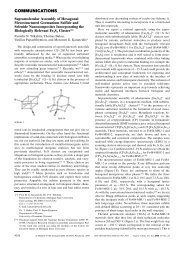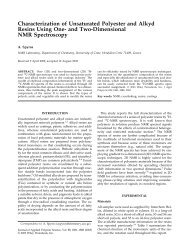Humic Acids: Marvelous Products of Soil Chemistry - Department of ...
Humic Acids: Marvelous Products of Soil Chemistry - Department of ...
Humic Acids: Marvelous Products of Soil Chemistry - Department of ...
Create successful ePaper yourself
Turn your PDF publications into a flip-book with our unique Google optimized e-Paper software.
N < 1 in the Freundlich equation (eq 2)<br />
A = K fc N (2)<br />
where A is the mass <strong>of</strong> sorbed solute per unit mass <strong>of</strong> HA, K f<br />
is the sorption coefficient, and c is the equilibrium solute concentration.<br />
For solute distribution between water and a structureless<br />
“liquid” HA phase, N would be 1. Another clue<br />
comes from competition between solutes for adsorption (48).<br />
Data for adsorption <strong>of</strong> hydrophilic solutes such as uracil fit<br />
the Langmuir equation (eq 3) for specific adsorption in<br />
sequential steps A, B, and C. Here, K is the equilibrium<br />
constant and v is the site capacity. As expected, adsorption<br />
<strong>of</strong> hydrophilic solutes is competitive. Physical adsorption<br />
results in higher solute desorption rates than for chemically<br />
sorbed solutes (e.g., by condensation <strong>of</strong> amines with HA<br />
carboxylic acid groups) (34).<br />
A = Kvc/(1 + Kc) (3)<br />
Solid HAs have an unusual ability to “create” additional<br />
adsorption sites by disaggregation as a result <strong>of</strong> primary organic<br />
solute adsorption. Linear correlation <strong>of</strong> the thermodynamic<br />
adsorption parameters ∆H i and ∆S i for every solute and adsorption<br />
step indicates that HAs selectively bind solutes with<br />
small, fairly constant, negative free-energy changes. That is,<br />
they are free-energy buffers, which is made possible by compensating<br />
enthalpy and entropy changes for adsorption. Water<br />
and bound metals evidently play major roles in HA–solute<br />
interactions and in HA aggregation/disaggregation (34, 49).<br />
<strong>Humic</strong> acids have higher metal-binding capacities than<br />
most commercial ion exchangers and they selectively bind,<br />
store, and release metals. <strong>Humic</strong> acids can be used in soil<br />
remediation to trap contaminants. They also can transport<br />
metals to other sites. Metals principally are bound by HA<br />
carboxylate groups (50), which means that HAs act at least<br />
in part as weak-acid cation exchangers. Bound metals and<br />
minerals reduce HA flexibility and cause HA aggregation (49),<br />
or they block the sorption sites and reduce the sorption<br />
capacity (51). HAs’ molecular flexibility enables them to wrap<br />
around a metal center. Metals also can bridge functional<br />
groups on different HA molecules (34, 50). X-ray absorption<br />
fine-structure spectroscopy (XAFS) and X-ray absorption nearedge<br />
spectroscopy (XANES) are helping us to understand how<br />
HAs bind metals. They identify the metals and their oxidation<br />
states as well as their binding sites (14, 52, 53).<br />
Other HA Sources<br />
Humus and potting soil sales are big business, but it makes<br />
little sense to replenish large amounts <strong>of</strong> desert with soil from<br />
another location. Polyphenols and lignins have only part <strong>of</strong><br />
soil HAs’ attributes because they are more aromatic and need<br />
to be modified, for example as in Figure 5. One solution to<br />
soil shortages is accelerated large-scale composting, which is<br />
<strong>of</strong> worldwide interest (7). Plants that contain HAs are good<br />
composting feedstock. Another HA source is s<strong>of</strong>t brown coals<br />
and Leonardite, which contain up to 80% extractable HAs<br />
that resemble soil HAs but are more aromatic (46 ). These<br />
economical coal-derived HAs are useful for soil and water<br />
remediation. They promote plant growth by improving the<br />
availability <strong>of</strong> Fe, Zn, and other micronutrients (54, 55).<br />
<strong>Chemistry</strong> for Everyone<br />
Conclusions<br />
<strong>Humic</strong> acids are essential and remarkable products <strong>of</strong> soil<br />
chemistry. Current HA models help to explain their origin<br />
and behavior as flexible, aliphatic-aromatic, and highly<br />
functionalized molecules. Composting and economical HA<br />
extraction from coal will help to combat water and soil<br />
pollution, fight soil erosion, and lessen our dependence on<br />
chemical fertilizers.<br />
Literature Cited<br />
1. <strong>Humic</strong> Substances in <strong>Soil</strong> and Crop Science: Selected Readings;<br />
MacCarthy, P.; Clapp, C. E.; Malcolm, R. L.; Bloom, P. R.,<br />
Eds.; American Society <strong>of</strong> Agronomy: Madison, WI, 1990.<br />
2. Stevenson, F. J. Humus <strong>Chemistry</strong>, 2nd ed.; Wiley: New York,<br />
1994.<br />
3. Sparks, D. L. Environmental <strong>Soil</strong> <strong>Chemistry</strong>; Academic Press:<br />
San Diego, 1995.<br />
4. Steelink, C. J. Chem. Educ. 1977, 54, 599–603.<br />
5. Steelink, C. J. Chem. Educ. 1963, 40, 379–384.<br />
6. Wershaw, R. L. <strong>Soil</strong> Sci. 1999, 164, 803–813.<br />
7. The Science <strong>of</strong> Composting: Parts 1 and 2; de Bertoldi, M.;<br />
Sequi, P.; Lemmes, B.; Papi, T., Eds.; Blackie Academic and<br />
Pr<strong>of</strong>essional: Glasgow, 1996.<br />
8. Hayes, M. H. B. In <strong>Humic</strong> Substances: Structures, Properties<br />
and Uses; Davies, G.; Ghabbour, E. A., Eds.; Royal Society <strong>of</strong><br />
<strong>Chemistry</strong>: Cambridge, 1998; pp 1-27.<br />
9. Jenkinson, D. S.; Adams, D. E.; Wild, A. Nature 1991, 351,<br />
304–306.<br />
10. <strong>Humic</strong> Substances: Structures, Properties and Uses; Davies, G.;<br />
Ghabbour, E. A., Eds.; Royal Society <strong>of</strong> <strong>Chemistry</strong>: Cambridge,<br />
1998.<br />
11. Understanding <strong>Humic</strong> Substances: Advanced Methods, Properties<br />
and Applications; Ghabbour, E. A.; Davies, G., Eds.; Royal<br />
Society <strong>of</strong> <strong>Chemistry</strong>: Cambridge, 1999.<br />
12. Wild, A. <strong>Soil</strong>s and the Environment: An Introduction; Cambridge<br />
University Press: New York, 1993; Chapter 12, pp 233–<br />
248.<br />
13. Schulten, H.-R.; Monreal, C. M.; Schnitzer, M.<br />
Naturwissenschaften 1995, 82, 42–44.<br />
14. Davies, G.; Fataftah, A.; Cherkasskiy, A.; Ghabbour, E. A.;<br />
Radwan, A.; Jansen, A. S.; Kolla, S.; Paciolla, M. D.; Sein, L.<br />
T. Jr.; Buermann, W.; Balasubramanian, M.; Budnick, J.; Xing,<br />
B. J. Chem. Soc. Dalton Trans. 1997, 4047–4060.<br />
15. Pierce, R. H. Jr.; Felbeck, G. T. Jr. Proc. Int. Mtg. <strong>Humic</strong> Substances<br />
Niewersluis 1972, 217–232.<br />
16. Willey, R. J.; Radwan, A.; Vozzella, M. E.; Fataftah, A.;<br />
Ghabbour, E. A.; Davies, G. J. Non-Cryst. Solids 1998, 225,<br />
30–35.<br />
17. Rice, J. A.; MacCarthy, P. Environ. Sci. Technol. 1991, 24,<br />
1875–1877.<br />
18. Paciolla, M. D.; Kolla, S.; Sein, L. T. Jr.; Varnum, J. M.;<br />
Malfara, D. L.; Davies, G.; Ghabbour, E. A.; Jansen, S. A. In<br />
<strong>Humic</strong> Substances: Structures, Properties and Uses; op. cit., pp<br />
203–214.<br />
19. Scott, D. T.; McKnight, D. M.; Blunt-Harris, E. L.; Kolesar, S.<br />
E.; Lovley, D. R. Environ. Sci. Technol. 1998, 32, 2984–2989.<br />
20. Myneni, S. C. B.; Brown, J. T.; Martinez, G. A.; Meyer-Llse,<br />
W. Science 1999, 286, 1335–1337.<br />
21. Haberhauer, G.; Bednar, W.; Gerzabeck, M. H.; Rosenberg,<br />
E. In <strong>Humic</strong> Substances: Versatile Components <strong>of</strong> Plants, <strong>Soil</strong>s<br />
JChemEd.chem.wisc.edu • Vol. 78 No. 12 December 2001 • Journal <strong>of</strong> Chemical Education 1613




